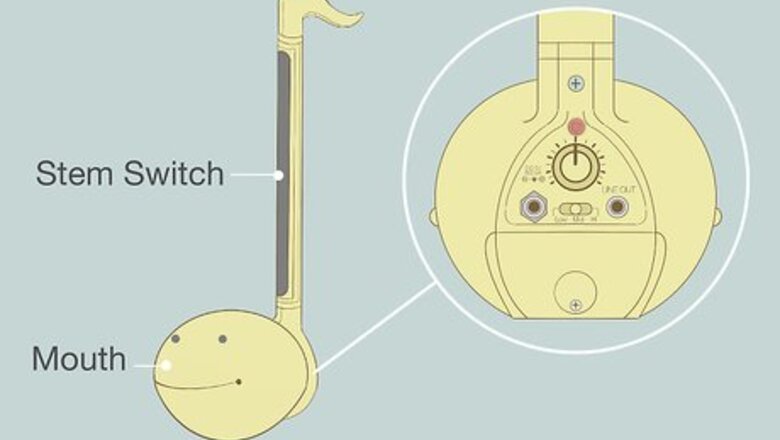
views
Familiarizing Yourself with the Otamatone
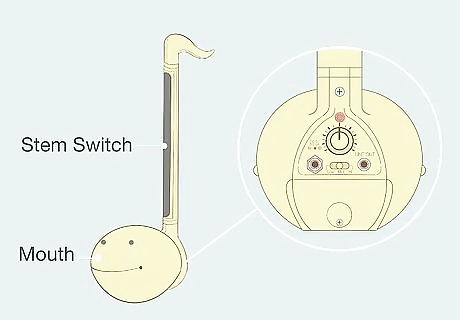
Identify the stem switch, mouth, and controls. The bulbous base of the instrument is called the mouth, which features a small slit that can open and close to produce sound variations. The power, volume, and octave controls of the instrument will be on the backside of the mouth. The stem coming up from the base is called the stem switch—your fingers will be moving up and down the switch stem to play different notes. The control panel on the back of the base differs from model to model. The standard Otamatone will have a power/volume switch and an octave switch while the deluxe Otamatone has a power/volume knob, octave switch, a headphone jack, and an amp jack.
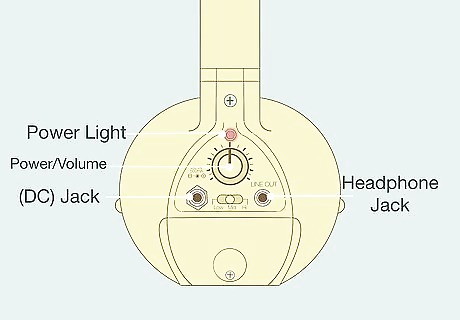
Examine the back panel to determine if you have a standard or deluxe model. You’ll need to know which model you have to understand its parts and capabilities better. Deluxe Otamatones tend to be larger than standard models, but there are also several differences in their features and how they’re played. A deluxe model will have 1 knob that controls both the power and the volume. A standard model will only have a power switch and a simple “high” or “low” volume setting. A deluxe Otamatone has a power light that shines red when the instrument is switched on. A deluxe Otamatone has 2 ports on either side of the octave switch—1 for headphones and 1 output (DC) jack.
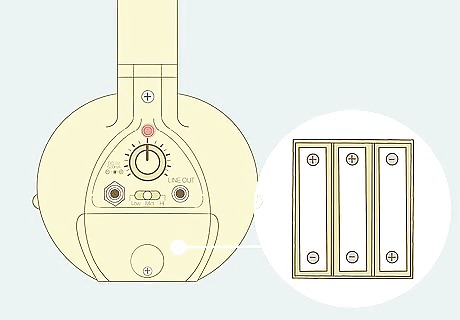
Insert the batteries into the back of the base. Use a coin or similarly sized item to open the battery hatch located on the back of the base just below the controls. Slide the battery box out of the base and insert 3 AA batteries (alkaline is preferred) facing the proper directions. For the standard model, you don’t need to slide anything out—insert the batteries directly into the base in the correct position. The positive side of the battery with the bump should touch the flat end of the battery cartridge and the negative, flat end of the battery should touch the coil.
Playing the Otamatone
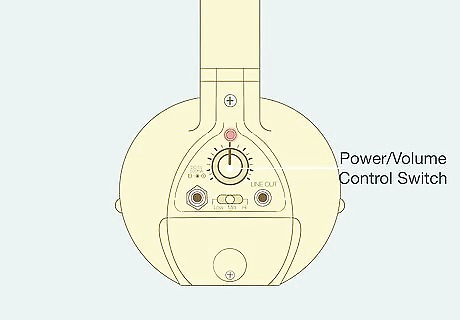
Adjust the power control switch to the right to turn it on. Look at the back panel of the base where all the knobs are to find a power switch. If you have a standard model, slide it to the right until you hear a click. If you have the deluxe model, turn the power/volume knob to the right until the power light turns on. For the deluxe version, if the light doesn’t come on, you may need to change the batteries.

Turn the knob or slide the switch to the high or low volume setting. Locate the knob on the base (or "tadpole") of the instrument and look for a knob that denotes sound. On the standard version, it will be marked by a speakerphone symbol with 2 or 3 lines next to it. For the deluxe model, simply turn the power/volume knob to the right to increase the volume. If you plan to record a song on your Otamatone, it's best to use the loudest setting.

Hold the base in your left hand with your fingers on the dots. Grip the base (or "tadpole") of the Otamatone with your left hand. Make sure the mouth is facing away from your body. Place your index finger and thumb on the raised dots located on either side of the mouth. The dots on the base are pinched to open the mouth of the instrument, which changes the sound from "woo" to "wah." If you are left-handed, it may be more comfortable to grip the base with your right hand and the stem with your left.
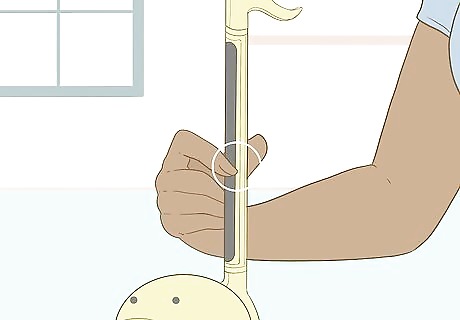
Hold the stem between your thumb and index finger. Place your right hand anywhere on the stem and lightly grip it between your thumb and index finger. Practice moving your hand up and down the stem using this light grip. Use your left hand to steady the instrument in an upright position to make it easier. A light grip is important because you'll be moving your fingers up and down the neck to produce different notes.
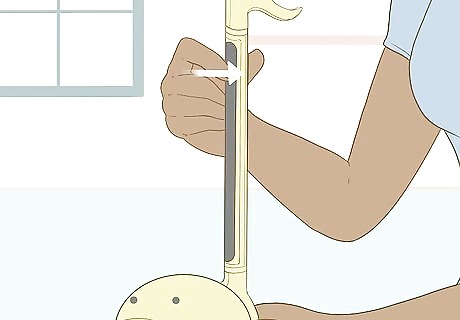
Push down anywhere on the stem to play a note. Start with your index finger placed at the very top of the stem switch to play the lowest note, which in most cases, is a C. Then, move your finger down to the next note to pay a C-sharp. Keep moving down in increments to hear each note in the octave. Lower notes are located at the top of the stem and the notes get higher as you move down the stem. If you have a digital version, the stem will have keys on it like a piano. The standard and deluxe models simply have a smooth bar that responds to the pressure from your fingers. Deluxe Otamatones start at C and go all the way up to a G-sharp (covering a single octave and half of the next octave), but some deluxe versions start at different notes (like from F to A). Refer to your Otamatone instruction manual to see how your Otamatone is set up. The standard model only covers a single octave covering C to C. Due to its small size, you don’t need to slide your finger very far down the stem to reach the next note. You can access a higher or lower octave by sliding the octave switch to the right or the left on the back of the base. Practice playing scales up and down, covering each note. Some people find the notes to be fairly close together, so the more you get used to small jumps from note to note, the better Otamatonist you’ll be!
Using Different Techniques
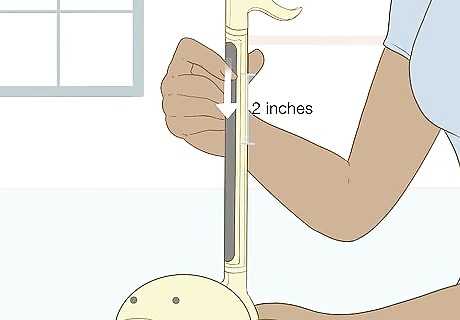
Play harmonies by placing 2 fingers on the stem switch. Use your index and middle finger to push down onto the stem in 2 different places. This will create a more rounded sound than playing a single note at a time. Playing harmonies is essential if you want to play more than just simple songs on the Otamatone. For standard and deluxe models, it may be hard to calculate just where two notes are located in relation to each other. Start by placing your fingers about 2 inches (5.1 cm) apart and adjust the distance according to what you hear. Once you get an ear for it, you’ll have a better idea of where harmonic notes are located along the stem. If you have a digital version, push 2 keys that have 1 key between them for an easy harmonic sound. Practice playing harmonies up and down the stem by first playing C with E, then D with F, E with G, and so on. This will help your muscles memorize the space between notes. Use a small tuner to find where C is or, if your model came with a player’s manual, refer to that to find the notes. You can also find note charts by doing an online search for “Otamatone note chart.”

Vibrate your index finger on the stem switch to play vibrato. Quickly lift, press down, lift, and press down on the stem with your index finger. Try to make the motion as quick and small as you can—it will take some practice! Vibrato is a pulsing effect in which the pitch slightly vibrates up and down (opera singers are typically known for using vibrato). Practice by playing vibrato scales up and down the stem (i.e., playing each note in a vibrating fashion). Once you master that, try vibrato harmonies using 2 fingers!
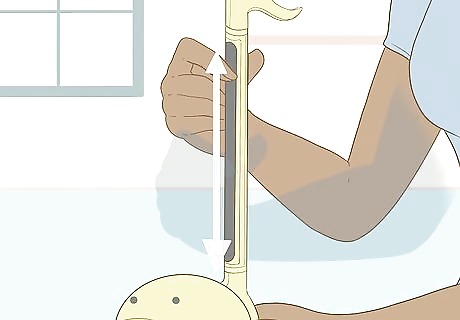
Slide your fingers up and down the stem to make a whistling sound. Instead of moving your fingers from one note to the next up and down the stem, glide them up or down from one note to the next. It may help to squeeze the base with your left hand to stabilize the instrument. This technique is similar to glissando on the piano, where the player uses 1 or 2 fingers to slide up or down the keyboard. Practice doing glissando between a few notes at a time to help you memorize the spacing of the notes along the stem. For instance, glide from C to F-sharp, then from C-sharp to G, D to G-sharp, and so on. Search online for a note chart if you’re not sure where the notes are located on the stem. If you have a digital model, the notes are laid out like piano keys, so you can figure out which key is which note by looking at a standard piano chart. You won’t be able to slide your finger up and down the stem, but you can use 4 of your fingers to play ascending or descending notes in quick succession to produce a similar sound effect.
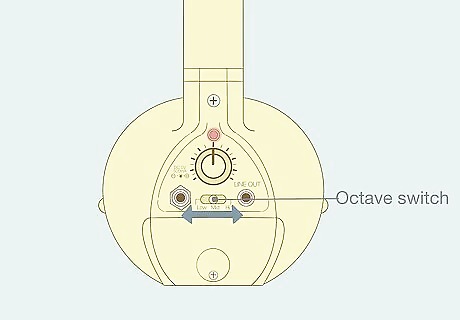
Select a low, medium, or high pitch. Look at the base of the instrument to find a knob relating to 3 different pitch settings. Set it to medium for casual playing, low for a droning sound effect, and high for sustained high-pitched notes. A high-pitched setting sounds great with vibrato, but you can play vibrato on any setting. The notes on the Otamatone cover a single octave at a time, so you may need to adjust the pitch mid-song to switch from higher to much lower notes.

Use your left index finger and thumb to open and close the mouth. Pinch the “cheeks” of the tadpole on either end of the mouth to open the slit. This will change the sound from a “woo” to a “wah.” Try opening the mouth while playing vibrato to produce a human-like sound. Practice pinching the cheeks while playing scales to get the hang of using both hands at the same time.



















Comments
0 comment